Glacier-like forms, polar ice caps, and permafrost on Mars, farfetched ice caps of frozen nitrogen on Pluto, unexpected thick ice deposits on the Moon and Mercury, frozen oceans on Jupiter’s moon Europa, reveal extraordinary frozen worlds out of the Earth in our solar system. The extraterrestrial cryosphere could provide important in-situ water resources for future human exploration of the planets in the solar system.
The origin of the term cryosphere has been traced to the Polish scientist A.B. Dobrowolski which used it in his 1923 book on “The Natural History of Ice – Historia Naturalna Lodu“, written in Polish. After him, Shumskii in 1964 and Reinwarth and Stäblein in 1972 elaborated the usage of this term.
The term cryosphere derives from the Greek word kryo, i.e. cold, and collectively describes the portion of the Earth system at and below the land and ocean surface where water is in its frozen state. In a wider definition, increasingly relevant today, the cryosphere includes also planetary and other forms of ices of the solar system and beyond. To know more about ice, glaciers, and permafrost in all their forms, you might start following the dedicated cryosphere section on learnweather.com

Climate and the cryosphere on Earth
The mean radius of the Earth is 6371 km (3959 miles) with a Circumference of about 40 thousand kilometers (about 24.9 thousand miles) and a surface area of about 510 million square kilometers (about 197 million square miles). Three-quarters of its atmosphere’s mass is contained within the first 11 kilometers (6.8 miles), the troposphere
The global mean surface annual air temperature of the Earth is 14°C (57°F). Surface air temperature can rise to around 55°C (131°F) in hot deserts such as the Death Valley. In Antarctica, the lowest temperature ever recorded fell as low as -89°C (-128°F). The estimated total ice volume in meters of sea-level equivalent is 65.64 m, of which 57.9 m in Antarctica, 7.42 m in Greenland Ice Sheet, and 0.32 m in glaciers and ice caps. In the figure below an image of the Earth’s South Polar Cap, Antarctica courtesy of NASA
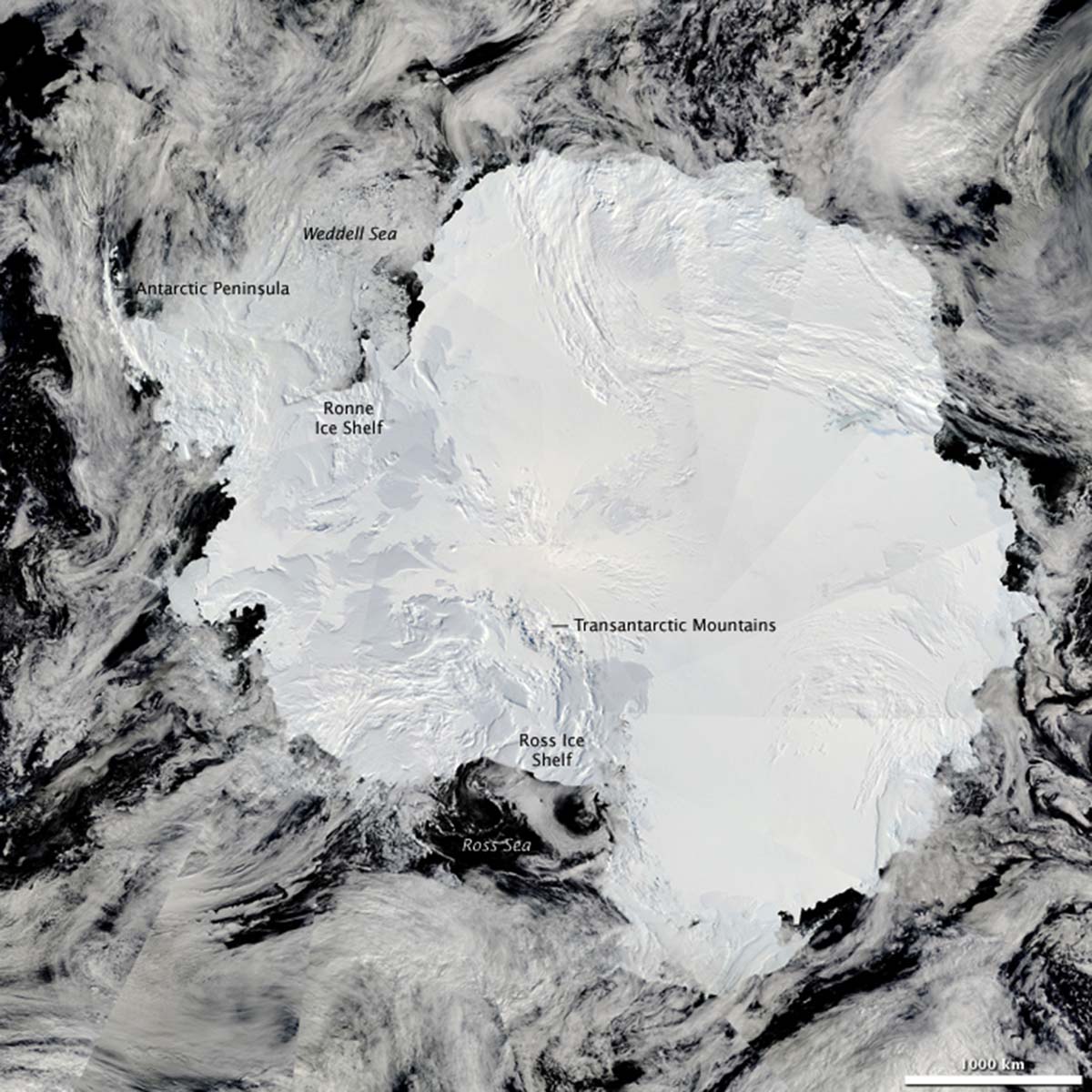
Ice caps and Glacier-like forms on Mars
Mars is much smaller than the Earth with only 11% of its mass and it is 50% farther from the Sun. Nevertheless, Mars’ climate has important similarities to Earth’s, such as seasonal changes, weather patterns, formation of clouds, and evidence of periodic ice ages. Mars’ atmosphere is 60% greater than that of the Earth.
Several different values of mean annual surface air temperature in different places of the Mars surface exist, but the common one is -63°C (-81°F). Extremes may reach 20°C (68°F) at the equator and -153°C (-243°F) at the poles. The warmest estimated soil temperature was 27°C (81°F).In the Gale crater located near the Martian Equator, an absolute maximum temperature of 20°C (68°F) in July and an absolute minimum temperature of -127°C (-197°F) have been recorded over the 4-year-period 2012-2015.
Mars has two polar ice caps following seasonal cycles. The northern polar ice cap has a diameter of about 1000 kilometers at its summer minimum. The average thickness is about 2 kilometers (1.2 miles) and the estimated volume is about 1.6 million cubic kilometers. The southern polar ice cap diameter is about 350 kilometers but the thickness is about 3 kilometers. The estimated value is very close to that of the north.
The two existing residual polar ice caps both consist primarily of water ice. The top unit is made of dry ice, namely frozen carbon dioxide (CO2), and accumulates as a thin layer 1-meter-thick. This is called seasonal ice and forms each Martian fall and winter disappearing when spring warms into summer.
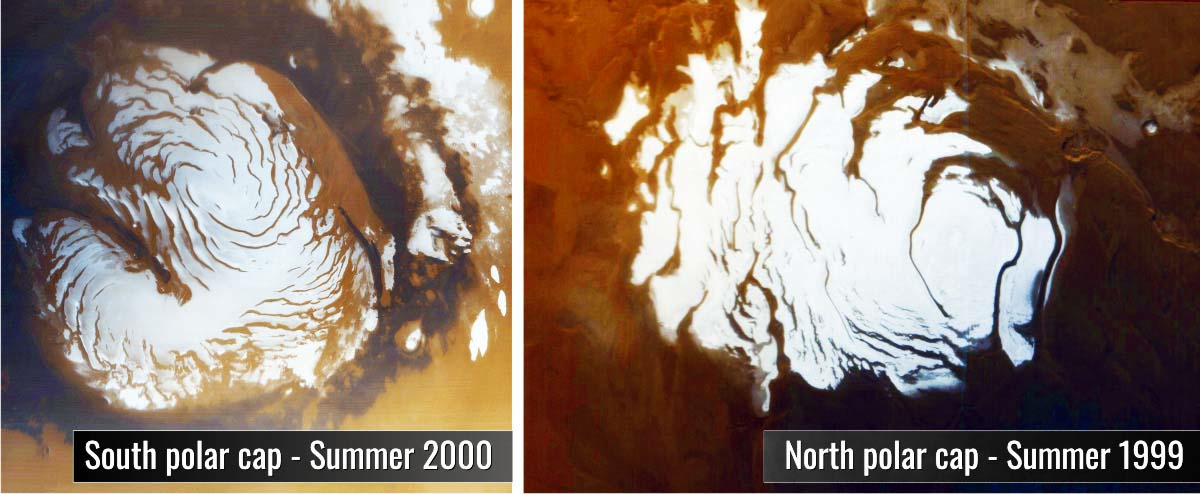
The image below shows a cross-section of part of the north polar ice cap of Mars, derived from data acquired by the Mars Reconnaissance Orbiter’s Shallow Radar (SHARAD). Thanks to the well-known electromagnetic characteristics of ice, the radar can image the ice stratigraphy and measure its thickness.
Data show internal ice structures through an almost 2 kilometers (1.2 miles) thick ice body. The base of the polar ice cap is clearly recognizable, as well as a basal unit interpreted as a mix of ice and debris, likely very old in age. The Ground or Airborne Penetrating Radar is used on Earth for the same purposes on ice sheets or small mountain glaciers.
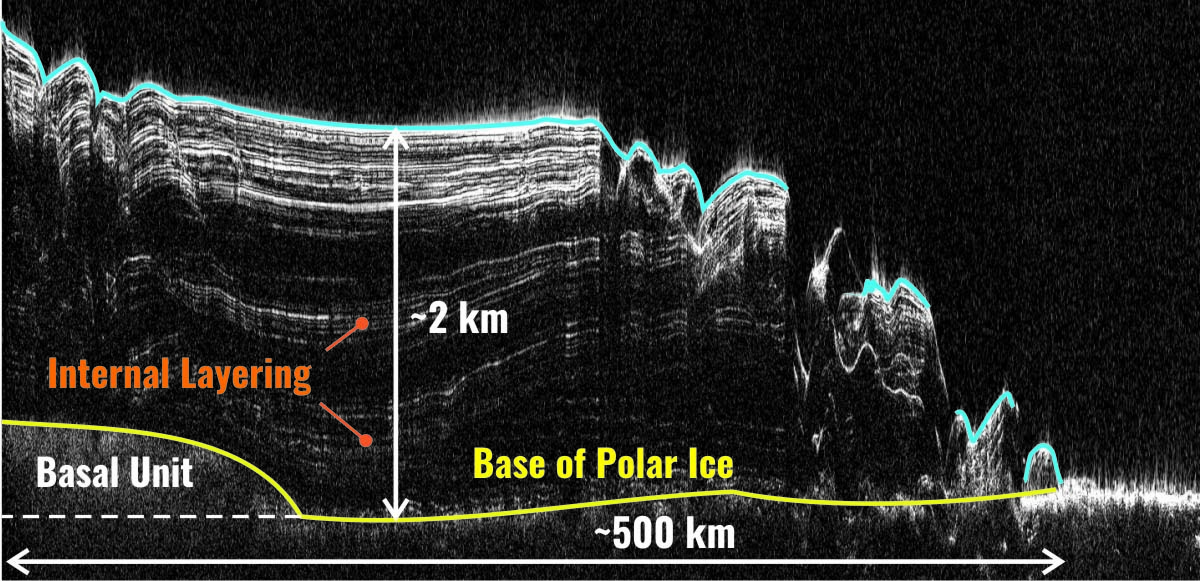
In the composite graphic below Credit: NASA/JPL-Caltech/University of Rome/Southwest Research Institute/the University of Arizona you can see the huge potential of the Shallow Radar instrument of NASA’s Mars Reconnaissance Orbiter for mapping underground ice-rich layers.
Pane ‘a’ shows icy layered deposits overlying basal units revealed by the penetrating radar along the cross-section highlighted in pane ‘c’. The vertical dimension is exaggerated one-hundred-fold compared with the horizontal dimension to better visualize the internal stratigraphy.
Pane ‘b’ shows a detail of the basal unit outcropping near the edge of the polar cap. Pane ‘c’ and ‘d’ are radar-generated maps of the surface elevation of the polar ice cap and the base respectively. Pane ‘e’ represents the thickness of the ice cap. The volume is roughly 30% of the Earth’s Greenland ice sheet.

The shallow radar instrument was provided by the Italian Space Agency. Data were jointly analyzed by a US-Italian science team. In the image below we prepared a graphic that should help better understanding the location of the radar diagram in the contest. The north polar ice caps made of water ice are mostly covered by dust and sand, especially towards the edges.
As it happens on Earth, during polar winter ice caps lie in darkness for several months. This chills the surface and causes deposition of 25-30 % of the atmosphere into slabs of dry ice, which again is CO2 ice. In summer the frozen CO2 sublimes giving an opportunity to the transportation of huge amounts of dust and water vapor.
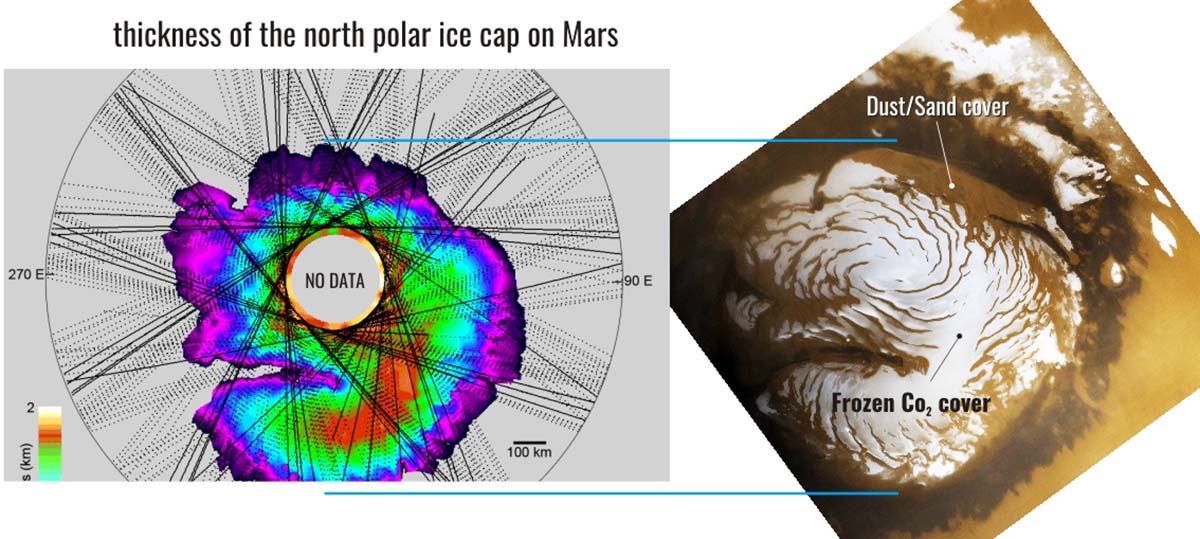
The process mentioned above might potentially give birth to cirrus clouds that have been already filmed several times both from rovers on the surface and from satellites. Indeed, this is the normal process active on Earth when clouds form. Nevertheless, recently have been supposed a different theory for cloud formation on Mars’ atmosphere.
Scientists long assumed that bits of surface dust lofted into the Martian atmosphere might be the source of the planet’s icy blue clouds. But a new study published in the journal Nature Geoscience (https://www.nature.com/articles/s41561-019-0379-6) argued that this might not be the case. According to a new study, the blue clouds of Mars may form as the result of tiny meteorite impacts in the planet’s atmosphere.
Outside the polar caps, thick ice deposits are often located inside impact craters over the Mars surface. One of the most stunning is the Korolev crater, an ice-filled impact crater located at 73° north latitude and 165° east longitude. The crater is 81.4 kilometers in diameter (50.6 miles) and its floor is almost 2 kilometers (1.2 miles) below the rim.
1.8 kilometers (1.1 miles) thick ice body made of water ice, is located at the center of the crater. Its diameter is about 60 kilometers (37 miles) and the estimated ice volume is about 2,200 cubic kilometers (530 cubic miles). In the video below, based on images taken by the European Space Agency Mars Express, you can see a virtual flight over this crater named Korolev after chief rocket engineer and spacecraft designer Sergei Pavlovich Korolev (1907-1966).
But surprisingly, in Mars’ mid-latitudes more than 1300 glacier-like forms exist, strikingly similar in plan form appearance to terrestrial valley glaciers. They are largely made of a mixture of ice and dust showing clear signs of viscous deformation. Many of them present crevasses suggesting complex dynamics and interactions with the bedrock. In fact, crevasses, fissures, or cracks on Earth’s glaciers are the result of changing stress produced by ice movement.
While no data have yet been obtained that reveal either rates or mechanisms of glacier-like forms movement on Mars, such motion has been both modeled and inferred from their overall lobate shape and the presence of flow structures on their surface.
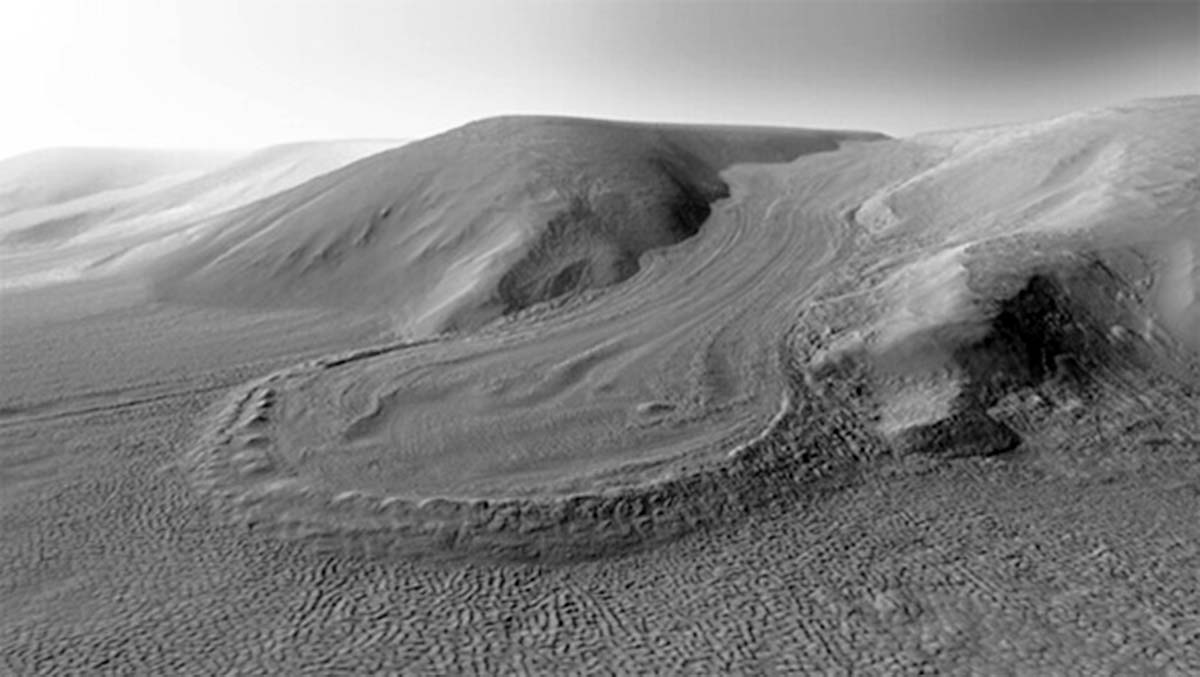
The figure above: A glacier-like form in Mars’ northern mid-latitudes
In the image below, partially modified by us after the original published on a stunning scientific paper by Hubbard B. and others, we highlight the extraordinary existing similarities between the terrestrial Midre Lovénbreen glacier, in Svalbard (Norway) (left-a), and a glacier-like form in a mountainous region of Mars (right-b).
We highlight here the glacier-terminus with the yellow dashed line, while the white dashed line shows the external moraines testifying older larger size of the glaciers. Imagining such earth-like structures on the planet Mars is truly something astonishing. It would be extremely nice to be able to witness the expression that the first glaciologist will have when he will find himself in front of a Martian glacier.
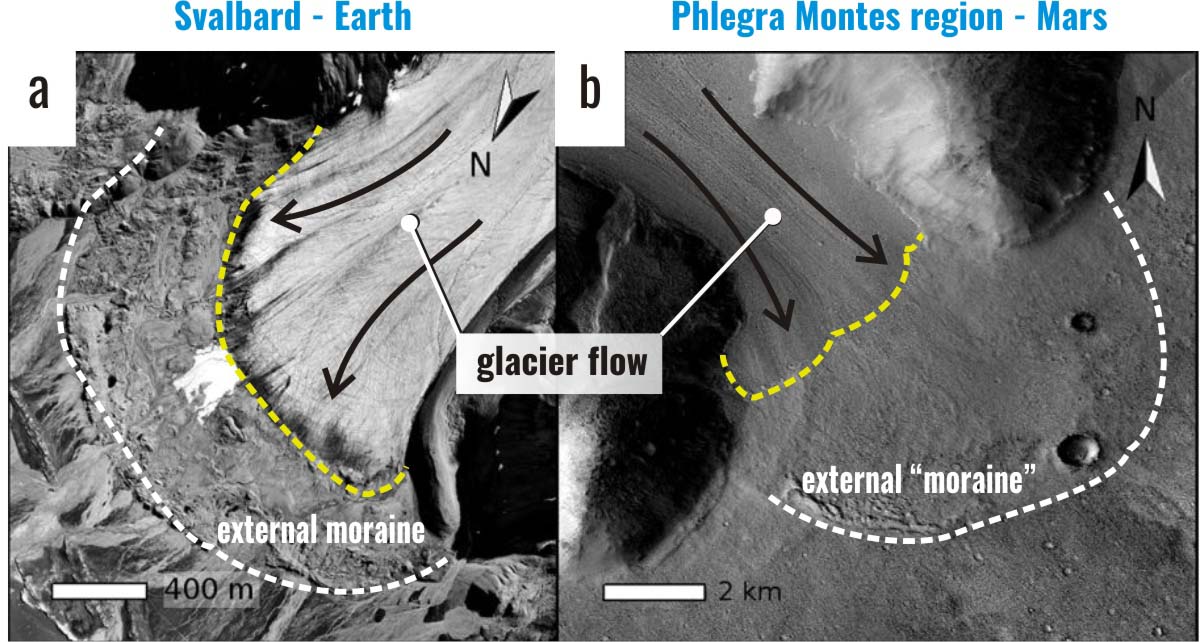
A global map of Mars showing the distributions of features thought to be debris-covered glaciers (shown in yellow) in Mars’ mid-latitude regions. The base map is made of color images from the Viking 1 and Viking 2 orbiters. The glacier distributions are from maps by Levy et al. 2014 3 and Souness et al. 2012 8. Image credit: F. Butcher
Permafrost on Mars
Permafrost, by definition, refers to the ground that remains below 0°C for at least two consecutive years. More briefly, we can define it as perennially cryotic ground. The term cryotic, better than frozen which implies the presence of ice, suggests a ground temperature below 0°C. In fact, ice is not necessary to characterize the Permafrost, which instead is exclusively defined by the thermal state of the ground. We were recently talking in deep about Earth’s permafrost. (https://www.severe-weather.eu/cryosphere/siberia-thawing-permafrost-batagaika-crater-rrc/)
With average temperatures around -63°C, permafrost exists at all latitudes on Mars and its thicknesses most likely range from 3.5 km at the equator to approximately 8 km in the polar regions. High-resolution imaging data from Mars show landforms strikingly similar to some in terrestrial permafrost environments.

The pair of images above from earthobservatory.nasa.gov show the similarities between the surface morphology of the Arctic plains of northern Mars (top), and permafrost on northeastern Spitsbergen, Svalbard (bottom). High centered polygonal patterns may have resulted from differential sublimation of high-gravimetric- content ice beneath polygon troughs in contrast to polygon centers
Thermal contraction cracking and polygon evolution is one of the most distinctive and widespread features of many high-latitude Earth’s permafrost environments. As the water in the soil freezes, the soil expands due to the 9% volume increase as water becomes ice. Resistance to thermal contraction produces tensile stress, and cracking occurs if this stress exceeds the tensile strength of the frozen ground.

The polygons in the scene above (credits NASA/JPL/UArizona) average approximately 100 meters (110 yards) in size and appear to be higher in elevation in the center than in the surrounding troughs. Boulders are accumulated in the center of the polygons and dunes are visible in several of the troughs. Therefore, these landforms most likely indicate that ice-rich permafrost is present or has been present in the past.
Nevertheless, several larger than 65 meters relict such landforms originally attributed to thermal contractions in the Martian permafrost, are too large to be caused by thermal contractions and provide further evidence of a warmer, wetter Martian past. For this reason, networks of giant polygonal troughs found in crater basins on Mars far from the poles, are likely cracks caused by evaporating lakes like the ones in the image below (credits JPL/NASA).

More, most of the Glacier-Like forms on Mars might be attributed to permafrost creep. Many of the subsurface ice related to the observed flow features described on Mars’ surface is part of Martian permafrost and its viscous flow is akin to permafrost creep on Earth.
On Earth, such features are generally called rock glaciers. Rock glaciers are thick lobate or tongue-shaped masses of debris slowly moving downslope through the deformation of subsurface ice and/or ice-rich sediments. In the image below, features at Mars’s mid-latitude regions (right) resemble those of the Peak rock glacier in Alaska (left). The similarities have led researchers to conclude that Mars, too, has rock glaciers on its surface.

Nitrogen glaciers on Pluto
Most of the appearance of Pluto is driven by seasonal variations. The direction of Pluto’s tilt and the distance from the Sun change over its 248-year orbit. Pluto lies billions of miles from Earth and seasonal temperatures range from-250 to -220°C (-418 to -364 °F).
Pluto could be defined as a paradise for glaciologists. Among the several types of ice covering its surface, nitrogen is the most volatile. When nitrogen sublimes (at -235 °C), it forms a thin atmosphere in equilibrium with the ice reservoir at the surface.
 Foto Sputnik planes
Foto Sputnik planes
Until now, the distribution of Pluto’s ice remained unexplained. The reservoir of solid nitrogen is extremely massive and mostly contained in Sputnik Planum, a topographic basin located within the tropics of Pluto. In the picture above credits NASA/JHUAPL/SWRI, the polar cap of Sputnik Planum, is surrounded by mountains that have been eroded and shaped by the glacial activity.
The nitrogen glaciers seem to flow out from the middle of Sputnik Planum and into the surrounding highlands and mountains, analogous to glaciers on Earth. Data gives evidence that glaciers move as temperatures rise, showing that the glaciers might expand and grow as the surface of the planet warms up
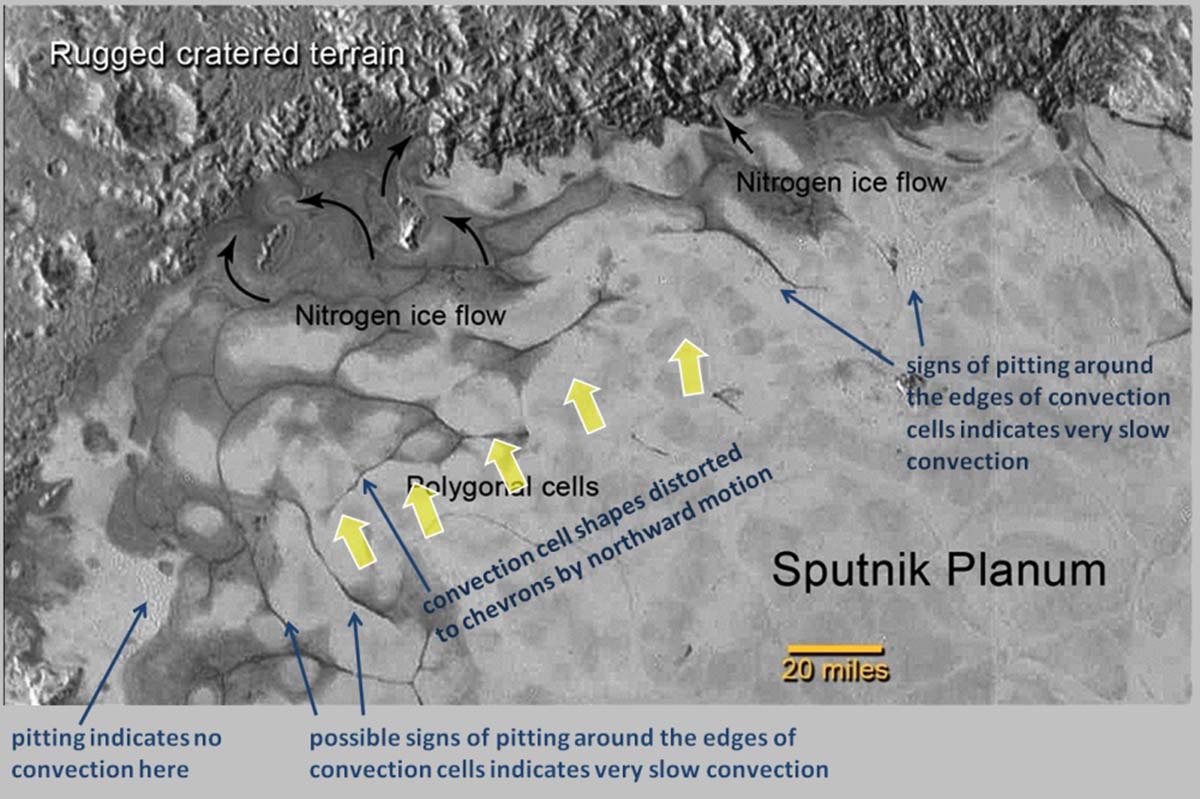
Ice deposit on the Moon and Mercury
Yes, you read that right. Earth’s Moon and Mercury, the closest planet to the Sun, surprisingly may contain significantly more water ice than previously thought.
Unlike Earth, the spin axes of Mercury and the Moon are oriented in a way that the Sun never rises high above the horizon in their polar regions. Accordingly, impact craters in polar areas or topographic depressions never see the Sun. The poles of Mercury and the Moon are among the coldest places in our solar system.
The possible water ice deposits are found in craters near the poles of both acting as cold-trap for geologic time periods.
Evidence of thick deposits of water ice on both Mercury and the Moon are discussed in a recent scientific paper from Rubanenko and others published in the journal Nature Geoscience

The figure above: A forced perspective view of Mercury’s cratered north pole, showing the presence of water ice in yellow. Credit: NASA/JHUAPL/CIW
In the past, thick ice deposits have been detected on Mercury through telescopic observations and orbiting spacecraft, but not on the Moon despite their similar thermal environments.
Craters on Mercury become distinctly shallower at higher latitudes, where ice is known to have accumulated on their floors.
A parallel investigation of approximately 12,000 lunar craters reveals a similar morphological trend near the south pole of the Moon. Scientists concluded is also due to the presence of thick ice deposits. If confirmed, this potential reservoir of frozen water on the Moon may be sufficiently massive to sustain long-term lunar exploration.
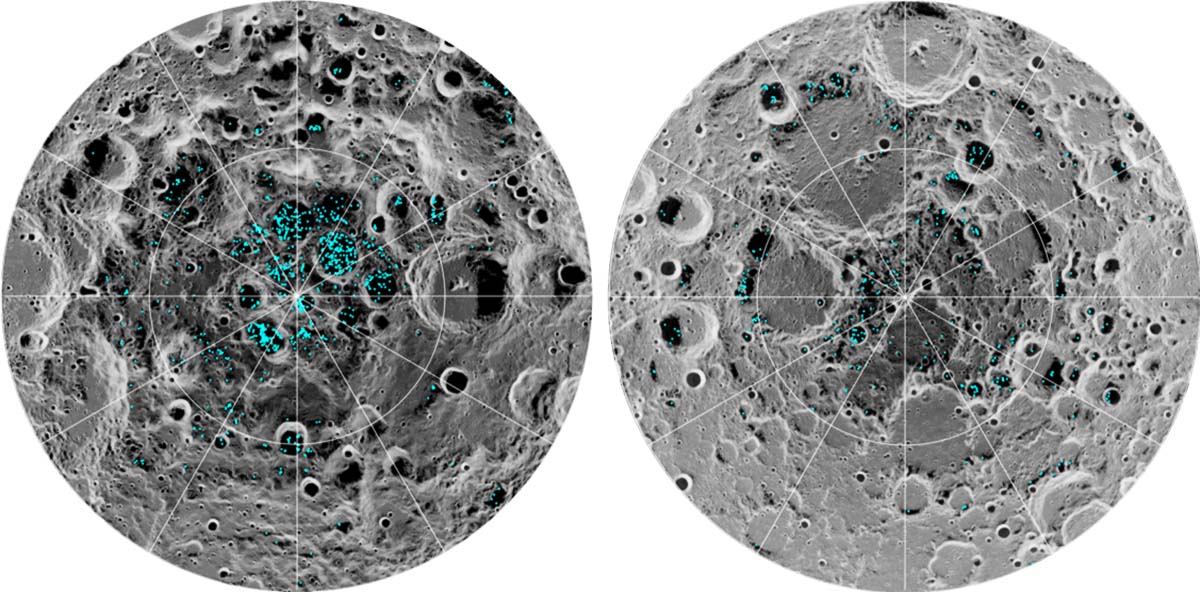
The image above shows the distribution of surface ice at the Moon’s south pole (left) and north pole (right), detected by NASA’s Moon Mineralogy Mapper instrument. Blue represents the ice locations
Frozen ocean on Jupiter’s moon Europa
Last but not least, let’s talk about Europa, one of the four moons of the biggest planet of the solar system, Jupiter. Slightly smaller than Earth’s Moon, Europa is primarily made of silicate rock and has a water-ice crust. Europa was discovered in 1610 by Galileo Galilei. Scientists think Europa’s ice shell is 15 to 25 kilometers (10 to 15 miles) thick, floating on an ocean 60 to 150 kilometers (40to 100 miles) deep.
Europa’s diameter is 3,100 kilometers (1,940 miles), about 90 percent the size of the Moon. Being completely frozen, Europa reflects 5.5 times the sunlight than our Moon does. Europa orbits Jupiter every 3.5 days and is locked by gravity to Jupiter. For this reason, the same hemisphere of the moon always faces the planet.
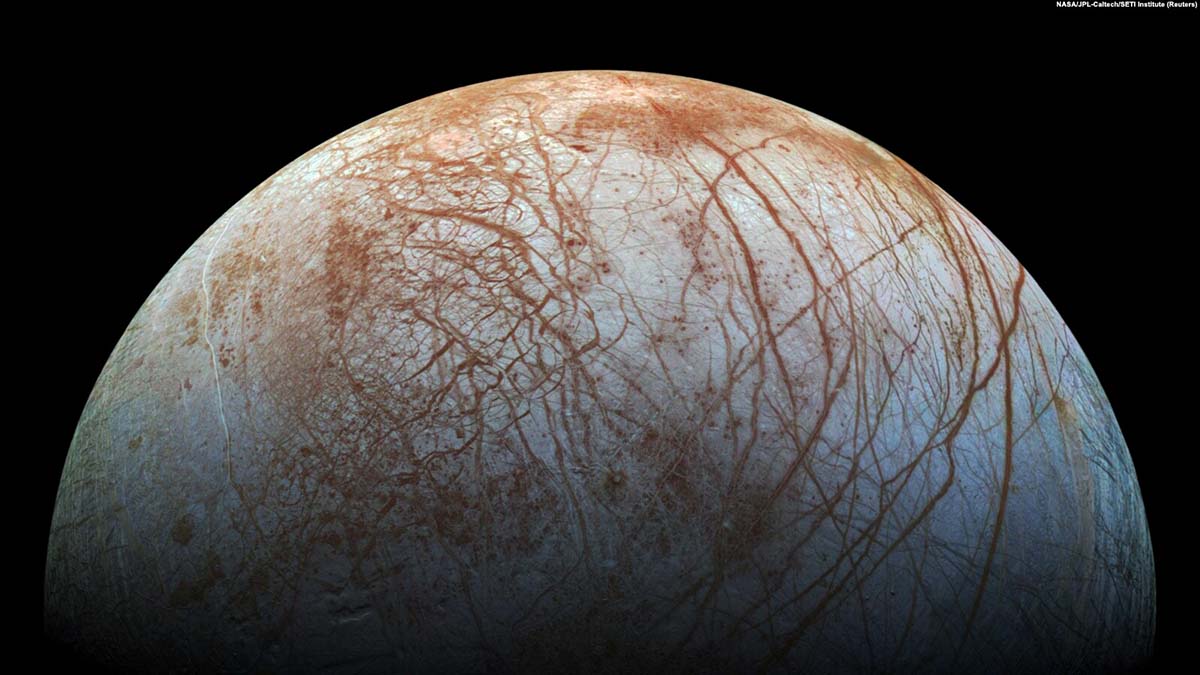
The ice shell is crossed by 1-2 kilometers wide linear fractures extending for thousands of kilometers across the moon. Along with those fractures, there is a reddish-brown material whose composition is not known for certain, but likely contains salts and sulfur compounds that have been mixed with the water ice and modified by radiation.
Although Europa is only one-fourth the Earth’s diameter, the ocean may contain twice the water of all oceans on Earth. Such a deep ocean is broadly considered the most encouraging place to look for life beyond Earth.
We will keep you updated on this and much more, so make sure to bookmark our page. Also, if you have seen this article in the Google App (Discover) feed or social media, click the like button (♥) to see more of our forecasts and our latest articles on weather, climate, and nature in general.
SEE ALSO: